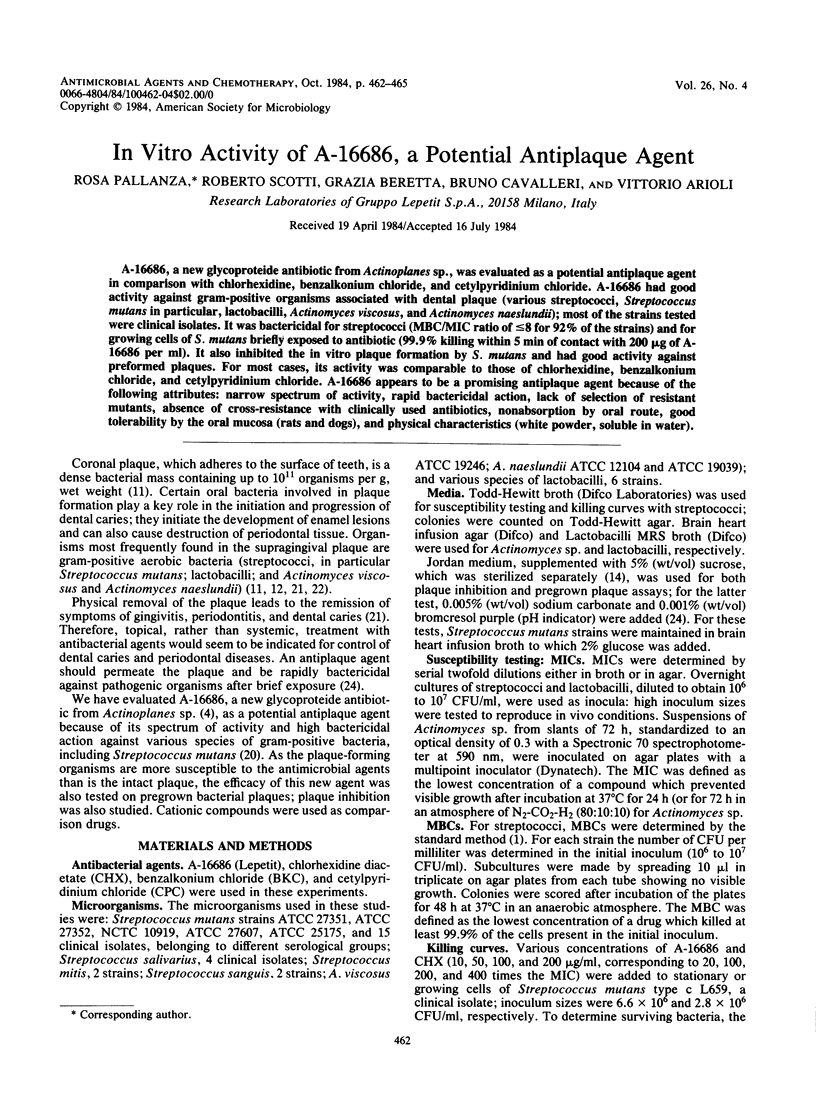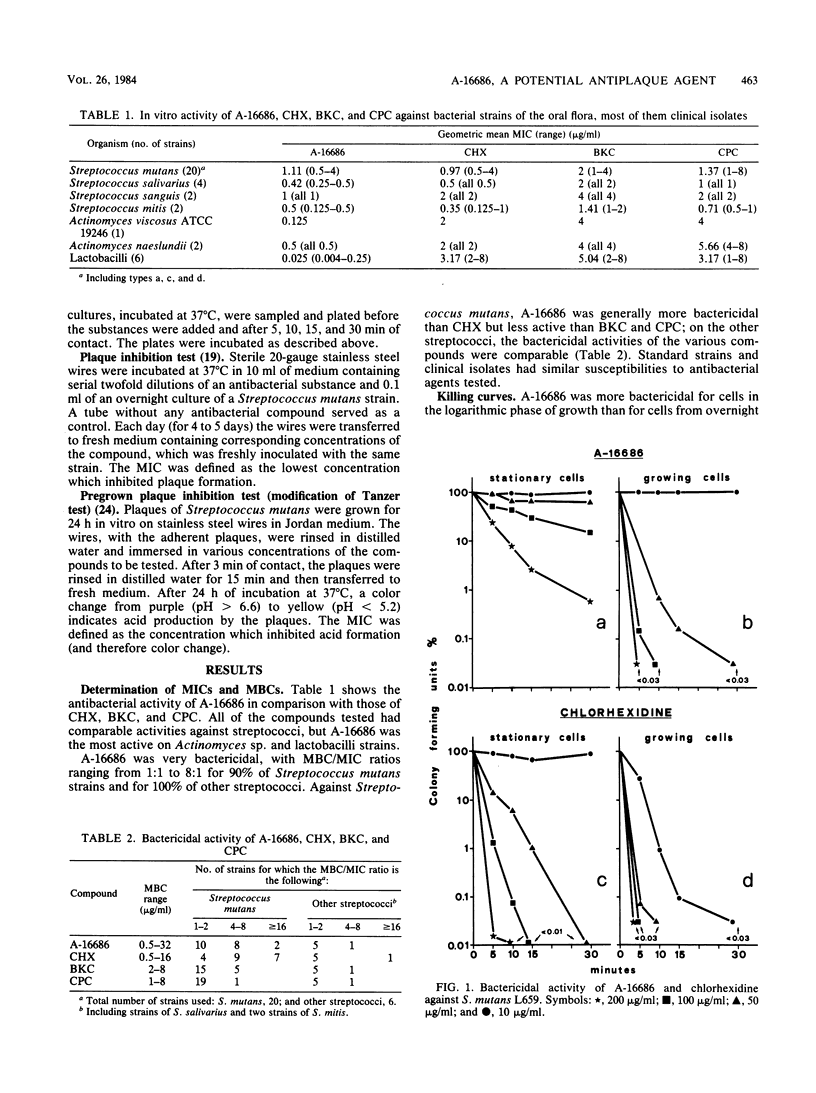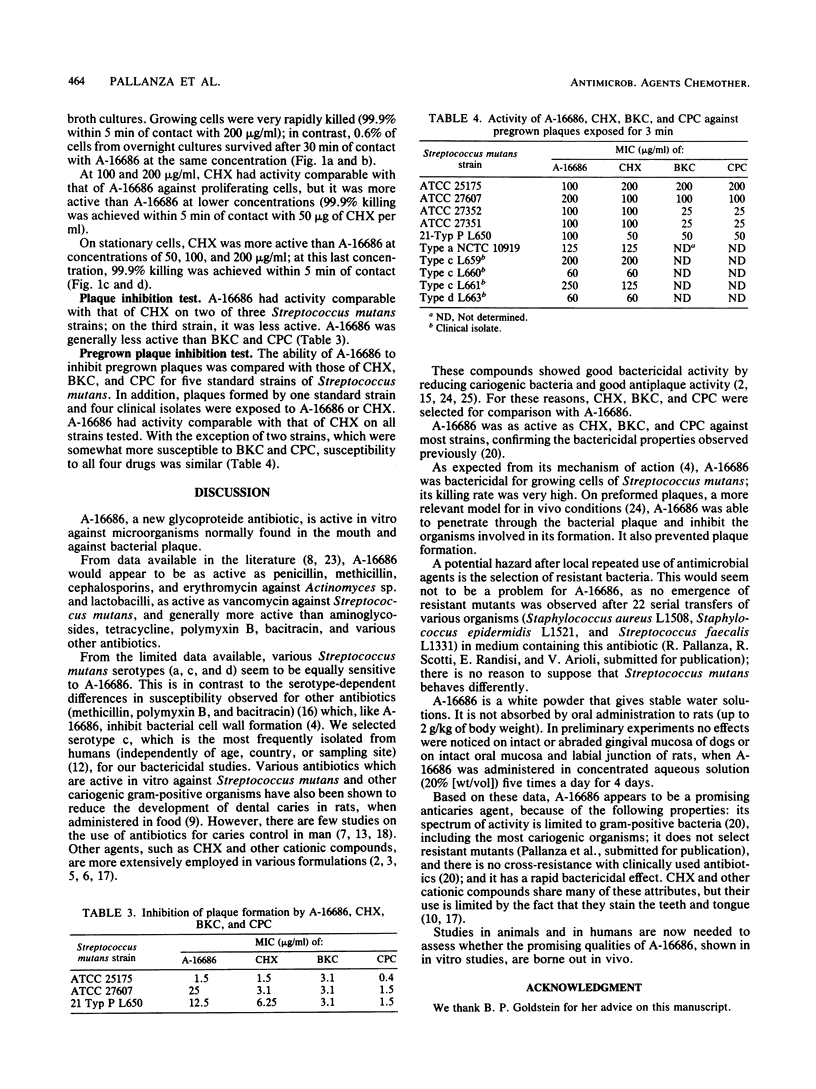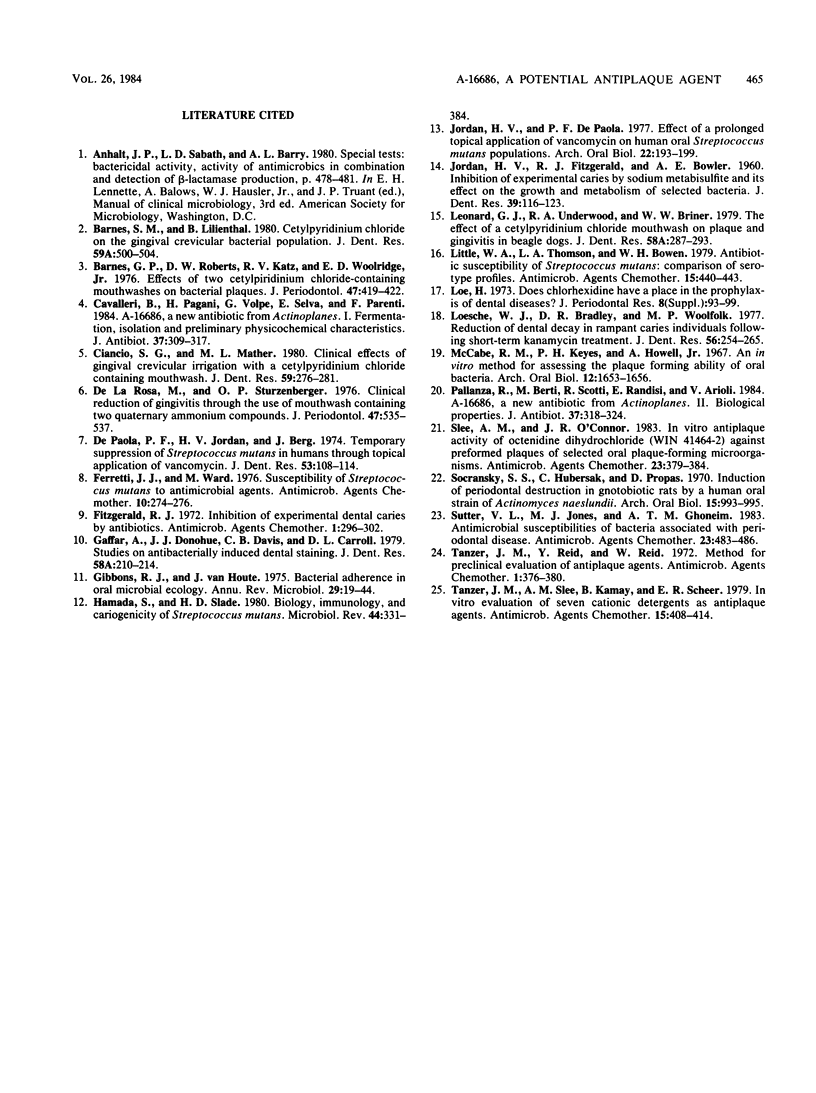Abstract
A-16686, a new glycoproteide antibiotic from Actinoplanes sp., was evaluated as a potential antiplaque agent in comparison with chlorhexidine, benzalkonium chloride, and cetylpyridinium chloride. A-16686 had good activity against gram-positive organisms associated with dental plaque (various streptococci, Streptococcus mutans in particular, lactobacilli, Actinomyces viscosus, and Actinomyces naeslundii); most of the strains tested were clinical isolates. It was bactericidal for streptococci (MBC/MIC ratio of less than or equal to 8 for 92% of the strains) and for growing cells of S. mutans briefly exposed to antibiotic (99.9% killing within 5 min of contact with 200 micrograms of A-16686 per ml). It also inhibited the in vitro plaque formation by S. mutans and had good activity against preformed plaques. For most cases, its activity was comparable to those of chlorhexidine, benzalkonium chloride, and cetylpyridinium chloride. A-16686 appears to be a promising antiplaque agent because of the following attributes: narrow spectrum of activity, rapid bactericidal action, lack of selection of resistant mutants, absence of cross-resistance with clinically used antibiotics, nonabsorption by oral route, good tolerability by the oral mucosa (rats and dogs), and physical characteristics (white powder, soluble in water).
Full text
PDF



Selected References
These references are in PubMed. This may not be the complete list of references from this article.
- Barnes G. P., Roberts D. W., Katz R. V., Woolridge E. D., Jr Effects of two cetylpyridinium chloride-containing mouthwashes on bacterial plaque. J Periodontol. 1976 Jul;47(7):419–422. doi: 10.1902/jop.1976.47.7.419. [DOI] [PubMed] [Google Scholar]
- Cavalleri B., Pagani H., Volpe G., Selva E., Parenti F. A-16686, a new antibiotic from Actinoplanes. I. Fermentation, isolation and preliminary physico-chemical characteristics. J Antibiot (Tokyo) 1984 Apr;37(4):309–317. doi: 10.7164/antibiotics.37.309. [DOI] [PubMed] [Google Scholar]
- De Paola P. F., Jordan H. V., Berg J. Temporary suppression of Streptococcus mutans in humans through topical application of vancomycin. J Dent Res. 1974 Jan-Feb;53(1):108–114. doi: 10.1177/00220345740530010201. [DOI] [PubMed] [Google Scholar]
- Ferretti J. J., Ward M. Susceptibility of Streptococcus mutans to antimicrobial agents. Antimicrob Agents Chemother. 1976 Aug;10(2):274–276. doi: 10.1128/aac.10.2.274. [DOI] [PMC free article] [PubMed] [Google Scholar]
- Fitzgerald R. J. Inhibition of experimental dental caries by antibiotics. Antimicrob Agents Chemother. 1972 Apr;1(4):296–302. doi: 10.1128/aac.1.4.296. [DOI] [PMC free article] [PubMed] [Google Scholar]
- Gibbons R. J., Houte J. V. Bacterial adherence in oral microbial ecology. Annu Rev Microbiol. 1975;29:19–44. doi: 10.1146/annurev.mi.29.100175.000315. [DOI] [PubMed] [Google Scholar]
- Hamada S., Slade H. D. Biology, immunology, and cariogenicity of Streptococcus mutans. Microbiol Rev. 1980 Jun;44(2):331–384. doi: 10.1128/mr.44.2.331-384.1980. [DOI] [PMC free article] [PubMed] [Google Scholar]
- JORDAN H. V., FITZGERALD R. J., BOWLER A. E. Inhibition of experimental caries by sodium metabisulfite and its effect on the growth and metabolism of selected bacteria. J Dent Res. 1960 Jan-Feb;39:116–123. doi: 10.1177/00220345600390010501. [DOI] [PubMed] [Google Scholar]
- Jordan H. V., DePaola P. F. Effect of prolonged topical application of vancomycin on human oral Streptococcus mutans populations. Arch Oral Biol. 1977;22(3):193–199. doi: 10.1016/0003-9969(77)90154-6. [DOI] [PubMed] [Google Scholar]
- Little W. A., Thomson L. A., Bowen W. H. Antibiotic susceptibility of Streptococcus mutans: comparison of serotype profiles. Antimicrob Agents Chemother. 1979 Mar;15(3):440–443. doi: 10.1128/aac.15.3.440. [DOI] [PMC free article] [PubMed] [Google Scholar]
- Loesche W. J., Bradbury D. R., Woolfolk M. P. Reduction of dental decay in rampant caries individuals following short-term kanamycin treatment. J Dent Res. 1977 Mar;56(3):254–265. doi: 10.1177/00220345770560031101. [DOI] [PubMed] [Google Scholar]
- Löe H. Does chlorhexidine have a place in the prophylaxis of dental diseases? J Periodontal Res Suppl. 1973;12:93–99. [PubMed] [Google Scholar]
- McCabe R. M., Keyes P. H., Howell A., Jr An in vitro method for assessing the plaque forming ability of oral bacteria. Arch Oral Biol. 1967 Dec;12(12):1653–1656. doi: 10.1016/0003-9969(67)90200-2. [DOI] [PubMed] [Google Scholar]
- Pallanza R., Berti M., Scotti R., Randisi E., Arioli V. A-16686, a new antibiotic from Actinoplanes. II. Biological properties. J Antibiot (Tokyo) 1984 Apr;37(4):318–324. doi: 10.7164/antibiotics.37.318. [DOI] [PubMed] [Google Scholar]
- Rosa M., Sturzenberger O. P. Clinical reduction of gingivitis through the use of a mouthwash containing two quaternary ammonium compounds. J Periodontol. 1976 Sep;47(9):535–537. doi: 10.1902/jop.1976.47.9.535. [DOI] [PubMed] [Google Scholar]
- Slee A. M., O'Connor J. R. In vitro antiplaque activity of octenidine dihydrochloride (WIN 41464-2) against preformed plaques of selected oral plaque-forming microorganisms. Antimicrob Agents Chemother. 1983 Mar;23(3):379–384. doi: 10.1128/aac.23.3.379. [DOI] [PMC free article] [PubMed] [Google Scholar]
- Socransky S. S., Hubersak C., Propas D. Induction of periodontal destruction in gnotobiotic rats by a human oral strain of Actinomyces naeslundii. Arch Oral Biol. 1970 Oct;15(10):993–995. doi: 10.1016/0003-9969(70)90095-6. [DOI] [PubMed] [Google Scholar]
- Sutter V. L., Jones M. J., Ghoneim A. T. Antimicrobial susceptibilities of bacteria associated with periodontal disease. Antimicrob Agents Chemother. 1983 Mar;23(3):483–486. doi: 10.1128/aac.23.3.483. [DOI] [PMC free article] [PubMed] [Google Scholar]
- Tanzer J. M., Reid Y., Reid W. Method for preclinical evaluation of antiplaque agents. Antimicrob Agents Chemother. 1972 May;1(5):376–380. doi: 10.1128/aac.1.5.376. [DOI] [PMC free article] [PubMed] [Google Scholar]
- Tanzer J. M., Slee A. M., Kamay B., Scheer E. R. In vitro evaluation of seven cationic detergents as antiplaque agents. Antimicrob Agents Chemother. 1979 Mar;15(3):408–414. doi: 10.1128/aac.15.3.408. [DOI] [PMC free article] [PubMed] [Google Scholar]


